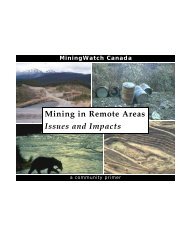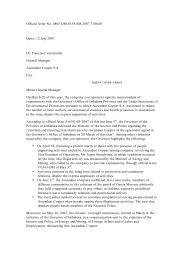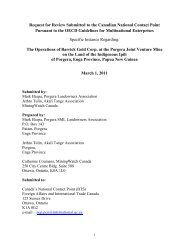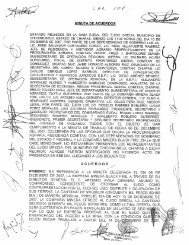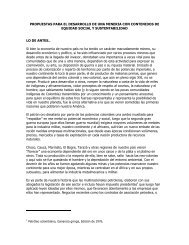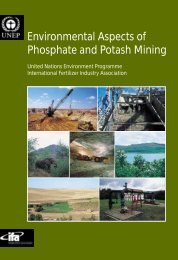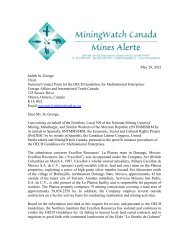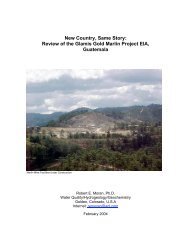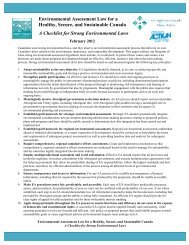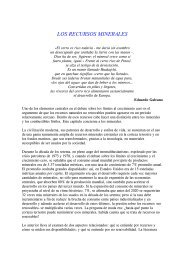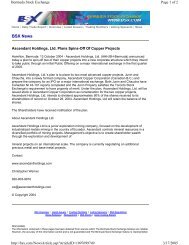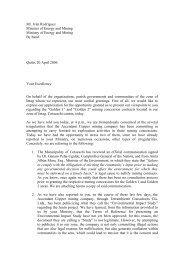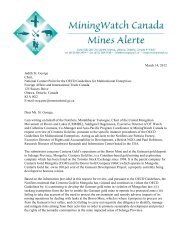Potential impacts of mining and processing chromite. Fact Sheet 1
Potential impacts of mining and processing chromite. Fact Sheet 1
Potential impacts of mining and processing chromite. Fact Sheet 1
Create successful ePaper yourself
Turn your PDF publications into a flip-book with our unique Google optimized e-Paper software.
Some studies suggest that plants convert all Cr-VI into Cr-III, but other studies have found<br />
Cr-VI <strong>and</strong> its intermediate forms, Cr-V <strong>and</strong> Cr-IV, persist in plants <strong>and</strong> algae. As Cr-VI, Cr-V<br />
<strong>and</strong> Cr-IV are involved in chromium’s most toxic effects in humans <strong>and</strong> some other animals,<br />
their presence in plants has the potential to threaten ecological health.<br />
Terrestrial Life<br />
Information on the doses <strong>of</strong> chromium in water or food that cause health problems in<br />
mammals come mostly from toxicology tests done in the lab on mice <strong>and</strong> rats. Effects observed<br />
on animals in experimental doses through food, water or injection include: cancers,<br />
reproductive harm, behavioral changes, reduced growth <strong>and</strong> reduced survival. Very few<br />
field studies have been conducted about the effects <strong>of</strong> environmental chromium pollution<br />
on wildlife <strong>and</strong> we did not find any information directly relevant to potential <strong>impacts</strong> <strong>of</strong><br />
<strong>chromite</strong> <strong>mining</strong> <strong>and</strong> ferrochrome production on terrestrial wildlife.<br />
Aquatic Life<br />
Chromium in aquatic ecosystems can harm algae, aquatic plants, invertebrates <strong>and</strong> fish.<br />
The amount <strong>of</strong> chromium taken up <strong>and</strong> stored in living tissue <strong>and</strong> its effects depend on factors<br />
such as species, organism size, sex <strong>and</strong> developmental stage, water characteristics <strong>and</strong><br />
presence <strong>of</strong> other contaminants. Toxic effects include:<br />
Units <strong>of</strong> Measurement:<br />
1 million micrograms (ug)<br />
equals 1 gram.<br />
1 thous<strong>and</strong> milligrams (mg)<br />
equals 1 gram.<br />
• reduced growth (algae, plants, invertebrates <strong>and</strong> fish)<br />
• decrease in successful reproduction (invertebrates <strong>and</strong> fish)<br />
• DNA damage (fish)<br />
• reduced weights (fish)<br />
• decreased disease resistance (fish)<br />
• reduced survival (plants, invertebrates <strong>and</strong> fish)<br />
Studies have observed Cr-VI toxicity on algae <strong>and</strong> aquatic plants exposed to as little as<br />
1-10 ug/L <strong>and</strong> on invertebrates <strong>and</strong> fish exposed to as little as 10 ug/L. In fish, Cr-VI harms<br />
internal organs such as the liver <strong>and</strong> kidney. Chromium-III in water seems to be more toxic<br />
to fish than Cr-VI. It can decrease fertilization success, deposit onto gills which damages<br />
tissue <strong>and</strong> function <strong>and</strong> can cause death at relatively low doses. Chromium-III has caused<br />
toxic effects on fish at 5 ug/L, on invertebrates at 44 ug/L <strong>and</strong> on algae at 320 ug/L.<br />
Chromium in mine <strong>and</strong> ferrochrome wastes can be much higher than the concentrations<br />
known to harm aquatic life. At an open pit <strong>chromite</strong> mine in India, Cr-VI in mine effluents<br />
ranged from 20 ug/L to 120 ug/L <strong>and</strong> in mine seepage from 50 ug/L to 1220 ug/L. In a<br />
study testing ferrochrome slag from Turkey, 610 ug/L <strong>of</strong> Cr-VI leached from crushed slag<br />
<strong>and</strong> 3800 ug/L <strong>of</strong> Cr-VI leached from ground slag.<br />
Biomagnification<br />
Biomagnification is an increase in the concentration <strong>of</strong> contaminants at higher levels <strong>of</strong><br />
a food chain as predators eat contaminated food, retain the contaminants <strong>and</strong> then pass<br />
them on to higher level predators. Toxic compounds that biomagnfy can seriously threaten<br />
ecosystem health. Chromium however, is not considered likely to biomagnify in aquatic<br />
<strong>and</strong> terrestrial food chains. A number <strong>of</strong> studies have actually found lower chromium<br />
concentrations in aquatic creatures higher up the food chain <strong>and</strong> there is no documented<br />
evidence for biomagnification <strong>of</strong> chromium from soil to plant to animal. This conclusion,<br />
however, is based on very few studies <strong>of</strong> the risk <strong>of</strong> chromium in food chains, <strong>and</strong> evidence<br />
does exist for biomagnification <strong>of</strong> chromium from wetl<strong>and</strong> invertebrates to their<br />
predators - birds.<br />
What don’t we know about the ecosystem risks <strong>of</strong> chromium?<br />
The majority <strong>of</strong> toxicity studies about chromium <strong>and</strong> environmental effects have been conducted<br />
in labs, which don’t fully account for complex field conditions. Scientists acknowledge<br />
there is a need for more research regarding chromium uptake, effects <strong>and</strong> risks in<br />
freshwater <strong>and</strong> terrestrial wildlife. Some key areas <strong>of</strong> uncertainty <strong>and</strong> lack <strong>of</strong> information<br />
include the following:



